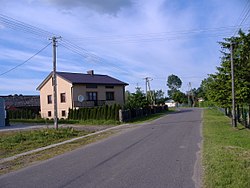엘리엇-할베르스탐 추측
Elliott–Halberstam conjecture수 이론에서 엘리엇-할베르스탐 추측은 산술 진행에서의 소수 분포에 대한 추측이다. 체 이론에는 많은 응용이 있다. 그것은 피터 D의 이름을 따서 지어졌다. 1968년 추측을 진술한 T. A. 엘리엇과 하이니 할버스탐.[1]
추측을 진술하는 것은 어떤 표기법을 필요로 한다. Let , the prime-counting function, denote the number of primes less than or equal to . If is a positive integer and is coprime to , we let denote displaystyle modulo 과 같은 x 보다 작거나 같은 소수 산술 진행에 대한 디리클레트의 정리:
여기서 은(는) 오일러의 토털 함수다. 그런 다음 오류 함수를 정의하면
최대값이 coprime을 에 대해 i < 1 {\< A> 0 {\A>0}에 C> 0 {\가 존재한다는 주장이다.
모든 > x 에 대해
이 추측은 엔리코 봄비에리와[2] A의 모든 </ 에 대해 입증되었다. I. 비노그라도프[3](Bombieri-Vinogradov 정리, 때로는 단순히 "Bombieri의 정리"라고도 함); 이 결과는 이미 상당히 유용하며, 일반화된 리만 가설의 평균적인 형태다. 엔드포인트 = 에서 추측이 실패한 것으로 알려져 있다[4]
엘리엇-할베르스탐 추측에는 여러 가지 결과가 있다. 한 가지 놀라운 것은 댄 골드스턴, 야노스 핀츠, 젬 얄드름에 의해 발표된 결과인데,[5][6] 이것은 (이 추측을 가정하면) 기껏해야 16번까지 차이가 나는 한 쌍의 프리임이 무한히 많다는 것을 보여준다. 2013년 11월 제임스 메이너드는 엘리엇-할베르스탐 추측에 따르면, 최대 12개의 차이가 나는 무한히 많은 연속 프리임의 존재를 보여줄 수 있다는 것을 보여주었다.[7] 2014년 8월 폴리매틱스 그룹은 일반화된 엘리엇-할베르스탐 추측에 따라 최대 6쌍까지 차이가 나는 무한히 많은 연속 프리임의 존재를 보여줄 수 있다는 것을 보여주었다.[8] 어떤 형태의 추측도 가정하지 않고, 가장 낮은 입증된 경계는 246이다.
참고 항목
메모들
- ^ Elliott, Peter D. T. A.; Halberstam, Heini (1970). "A conjecture in prime number theory". Symposia Mathematica, Vol. IV (INDAM, Rome, 1968/69). London: Academic Press. pp. 59–72. MR 0276195.
- ^ Bombieri, Enrico (1965). "On the large sieve". Mathematika. 12 (2): 201–225. doi:10.1112/s0025579300005313. MR 0197425.
- ^ Vinogradov, Askold Ivanovich (1965). "The density hypothesis for Dirichlet L-series". Izv. Akad. Nauk SSSR Ser. Mat. (in Russian). 29 (4): 903–934. MR 0197414. 코리젠덤. ibid. 30 (1966), 719-720페이지 (러시아어)
- ^ Friedlander, John; Granville, Andrew (1989). "Limitations to the equi-distribution of primes I". Annals of Mathematics. 129 (2): 363–382. doi:10.2307/1971450. JSTOR 1971450. MR 0986796.
- ^ Goldston, D. A.; Pintz, J.; Yildirim, C. Y. (2005). "Primes in Tuples I". arXiv:math.NT/0508185.
Goldston, D. A.; Motohashi, Y.; Pintz, J.; Yildirim, C. Y. (2005). "Small Gaps between Primes Exist". arXiv:math.NT/0505300.
Goldston, D. A.; Graham, S. W.; Pintz, J.; Yilidirm, C. Y. (2005). "Small gaps between primes or almost primes". arXiv:math.NT/0506067. - ^ Soundararajan, Kannan (2007). "Small gaps between prime numbers: The work of Goldston–Pintz–Yıldırım". Bull. Amer. Math. Soc. 44 (1): 1–18. arXiv:math/0605696. doi:10.1090/S0273-0979-06-01142-6. MR 2265008. S2CID 119611838.
- ^ Maynard, James (2015). "Small gaps between primes". Annals of Mathematics. 181 (1): 383–413. arXiv:1311.4600. doi:10.4007/annals.2015.181.1.7. MR 3272929. S2CID 55175056.
- ^ D.H.J. Polymath (2014). "Variants of the Selberg sieve, and bounded intervals containing many primes". Research in the Mathematical Sciences. 1 (12). arXiv:1407.4897. doi:10.1186/s40687-014-0012-7. MR 3373710. S2CID 119699189.






 (는)
(는) 





 모든
모든 


